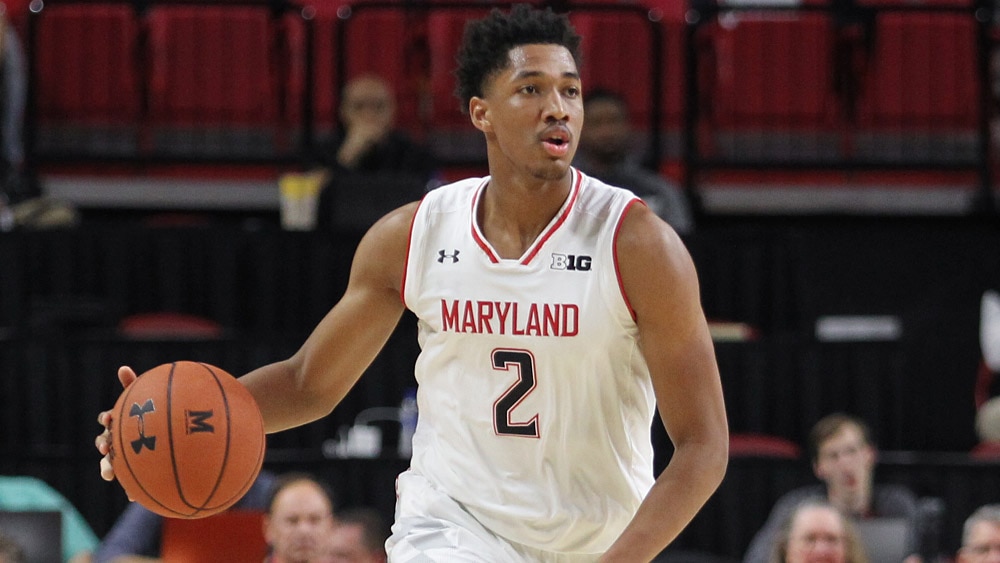The Maryland Terrapins have had a solid start to the season thus far, but poor 3-point shooting has hindered the team all season. Will things turn around?
After back-to-back road losses to Penn State and Seton Hall, the Maryland Terrapins found their footing at home. The team’s current three-game winning streak featured victories over Bryant, Indiana, and was capped off by a 67-55 victory over No. 11 Ohio State.
(Credit to KenPom and hoop-math for statistics)
While the recent stretch is encouraging, Mark Turgeon’s squad still seems to be playing below its potential. There’s one clear piece of evidence for this: poor 3-point shooting.
Last season, Maryland attempted threes at the 219th-highest rate and made a respectable 34.9% of them (143rd nationally). This season, the attempt rate has risen to 39.2% (141st), but their 3-point percentage has dropped significantly to 31.4% (236th).
It’s one thing to make threes at a lower rate, but when a team is also shooting more threes than the season prior, this can’t help but create some issues offensively. In spite of this, the Terrapins’ offense is ranked higher than last season per KenPom (22nd vs 31st), with an improved turnover percentage being the primary driver (234th to 84th).

The turnover issues of seasons past aren’t completely gone, as they reared their ugly head in the Seton Hall and Penn State losses (17 and 20 respectively). That being said, their 3-point shooting is what’s been really holding the team back this season. If it gets better, the Terrapins are a legitimate Final Four contender. Is there reason to expect improvement?
The long-range falloff can’t be explained by simply losing shooters from last season’s roster due to graduation, the draft, etc. Maryland returned 5/6 of its top 3-point weapons; let’s see how they’ve fared thus far compared to last season.
Last season: 2018-19
Anthony Cowan: 70-208 (33.7%)
Aaron Wiggins: 62-150 (41.3%)
Eric Ayala: 52-128 (40.6%)
Jalen Smith: 19-71 (26.8%)
Darryl Morsell: 18-62 (29.0%)
This season: 2019-20
Anthony Cowan: 30-84 (35.7%)
Aaron Wiggins: 23-78 (29.5%)
Eric Ayala: 18-70 (25.7%)
Jalen Smith: 11-30 (36.7%)
Darryl Morsell: 8-20 (40.0%)
What stands out? Cowan, Smith, and Morsell are all shooting better than last season, and the poor 3-point shooting has been driven by the sophomores in Wiggins and Ayala. Unsurprisingly, this duo shot especially poorly from 3-point range in the team’s Penn State and Seton Hall losses.
Penn State:
Wiggins: 1-6
Ayala: 1-4
Seton Hall:
Wiggins: 1-5
Ayala: 1-4
Can anything explain the shooting woes of these players?
Are they taking more difficult threes this season? It doesn’t seem so. While Wiggins has been assisted on essentially the same percentage of made 3-pointers compared to last season, Ayala is actually being assisted at a higher rate so far (per hoop-math), he’s assisted on often catch-and-shoot 3-pointers tend to be easier than the alternative the off-the-dribble shots, so a higher “assist percentage” should correlate with better shot quality. These statistics are far from perfect ways to measure this, but it seems this hasn’t been the issue.
% of made 3-pointers that were assisted: 2018-19
Wiggins: 87.1%
Ayala: 75.0%
% 3s assisted: 2019-20
Wiggins: 87.0%
Ayala: 82.4%
It’s also worth considering whether the longer 3-point line this season could be partially contributing to the duo’s percentage drop-off. After making 34.4% of their threes last season, D1 teams are hitting only 33.1% this go-round.

This might seem like just a minor slip, but if the season ended today, the 33.1% would mark the worst shooting season in the KenPom database (goes back to 1986-1987). Although this development certainly hasn’t helped Wiggins and Ayala’s cases, it’s likely just one piece of the puzzle.
Conclusion:
Should Maryland fans expect the shooting of Aaron Wiggins and Eric Ayala to turn around? Both shot really well on pretty substantial sample sizes last season, and neither players shooting seemed to be regarded as particularly “fluky” at the time. For these reasons, positive regression certainly seems to be a reasonable expectation.
If they both start knocking down threes, Maryland will reach another level. Although there’s plenty of reasons for optimism this will happen, they still need to hit the shots. The longer their slumps go on, the more in doubt it will be that the turnaround will happen at all.
